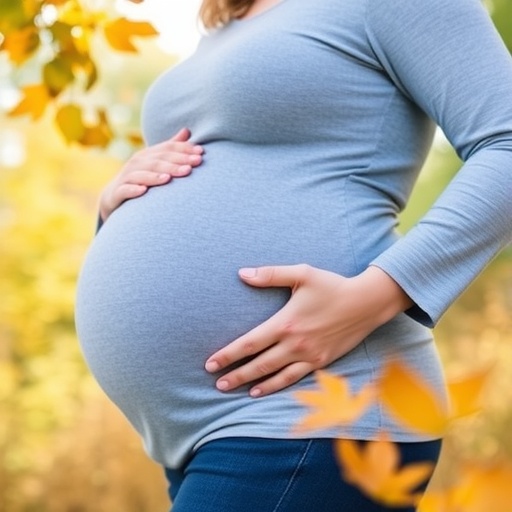Falls during pregnancy are a significant concern, affecting many women around the world. Pregnant individuals often experience a wide range of physiological, hormonal, and musculoskeletal changes that can impact their stability and balance. Recent research has shed light on this issue, emphasizing that understanding the factors associated with the risk of falls and the fear of falling is essential for pregnant women. A cross-sectional study conducted by Özcan, Durmuş, and Durmuş addresses these critical concerns, revealing insights that could help improve safety and awareness for expectant mothers.
The risk of falls in pregnant individuals is multifaceted and can arise from an interplay of various factors. Changes in body weight, alterations in center of gravity due to the developing fetus, and increased joint laxity can all contribute to instability. Additionally, the emotional and psychological impacts of pregnancy, including anxiety and fear of falling, can further exacerbate the likelihood of falls. Studies like the one conducted by Özcan et al. illustrate the pressing need to evaluate and mitigate these risks through comprehensive assessment and prevention strategies.
One of the notable findings of the research was the relationship between the fear of falling and actual fall incidents. Pregnant individuals who reported a heightened fear of falling were also more likely to experience an actual fall. This psychological barrier can lead to increased caution, which, while seemingly beneficial, may result in reduced mobility and activity levels. This pattern suggests that addressing fear itself is crucial for promoting a safer pregnancy experience.
Furthermore, the study identifies several associated factors that contribute to the risk of falls among pregnant women. These include physical activity levels, previous fall history, and even environmental factors such as home safety and accessibility. Understanding these variables can enable healthcare providers to tailor interventions that not only address physical safety but also consider psychological well-being.
The implications of these findings extend beyond individual safety; they underscore the importance of support systems for pregnant women. Family, friends, and healthcare professionals play a pivotal role in fostering an environment that encourages safe practices while alleviating fears associated with falling. Creating awareness about the potential risks and ensuring that pregnant individuals feel empowered to engage in safe physical activity can significantly enhance their overall health.
Additionally, the role of healthcare practitioners in educating and providing resources for pregnant women cannot be overstated. Regular check-ups should include assessments of fall risk factors and discussions around how to maintain balance and strength throughout pregnancy. Simple modifications, such as recommending safe exercise programs or home safety assessments, can lead to substantial improvements in reducing fall incidents.
The findings also point to the necessity for more extensive research into fall-related issues during pregnancy. While this study provides invaluable data, it opens the door for further investigations, particularly longitudinal studies that can track the evolution of fall risks across different stages of pregnancy. Such research could delve deeper into the long-term consequences of falls during pregnancy and inform best practices for prevention.
The importance of fostering a holistic approach to pregnant women’s health is evident, combining physical health management with mental health support. Strategies that promote emotional well-being, such as mindfulness and counseling, can effectively reduce anxiety and fear surrounding falls. By integrating these practices, healthcare systems can better support pregnant individuals, ensuring they have the tools necessary for a safe and healthy pregnancy.
As society becomes increasingly aware of the challenges faced by pregnant women, there is a growing call for community engagement in promoting a safer environment. Initiatives that focus on creating fall-proof spaces in homes and public areas can significantly mitigate risks. Additionally, community workshops aimed at educating both pregnant women and their support systems can foster a culture of safety and awareness, ultimately contributing to better health outcomes.
The potential benefits of this research extend to the broader field of maternal health. Understanding the intricacies of fall risks during pregnancy sheds light on the importance of comprehensive care models that prioritize both physical and psychological health. By considering the multifactorial aspects of falls, healthcare providers can develop more effective strategies to support pregnant women in navigating their unique journeys.
The study’s relevance transcends academic discourse; it has practical implications for improving the quality of life for pregnant individuals. As discussions about women’s health evolve, it is critical to include safety and fall prevention as essential components of prenatal care. The synthesis of research findings in this area can spur policy changes that prioritize maternal safety and encourage a more proactive approach to fall prevention.
In conclusion, the issue of falls during pregnancy is a multifaceted challenge that necessitates a comprehensive understanding of risk factors and psychological influences. The findings from Özcan, Durmuş, and Durmuş’s research provide a critical foundation for ongoing dialogue and action in the field of maternal health. Through collaborative efforts to educate, support, and empower pregnant individuals, we can make significant strides in ensuring safety and well-being throughout pregnancy.
Ultimately, the journey of pregnancy should be supported with knowledge, resources, and a strong community framework that embraces the complexities of this life-changing experience. As more studies are conducted, it is expected that the healthcare community will continue to evolve, integrate findings, and foster a culture of safety that addresses the concerns of all expectant mothers.
By understanding and tackling the risk of falls and the accompanying fear, there lies the potential to reframe the narrative around pregnancy as one not only of joy and anticipation but also of safety, empowerment, and holistic care.
Subject of Research: Fall risk and psychological aspects related to pregnancy.
Article Title: Risk of falls, fear of falling, and associated factors during pregnancy: a cross-sectional study.
Article References: Özcan, E., Durmuş, A. & Durmuş, M. Risk of falls, fear of falling, and associated factors during pregnancy: a cross-sectional study. BMC Nurs 24, 1420 (2025). https://doi.org/10.1186/s12912-025-04091-9
Image Credits: AI Generated
DOI: https://doi.org/10.1186/s12912-025-04091-9
Keywords: Falls, pregnancy, maternal health, psychological factors, fall prevention.




